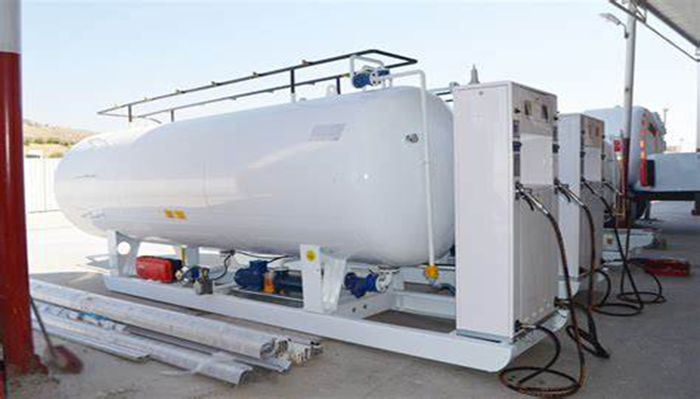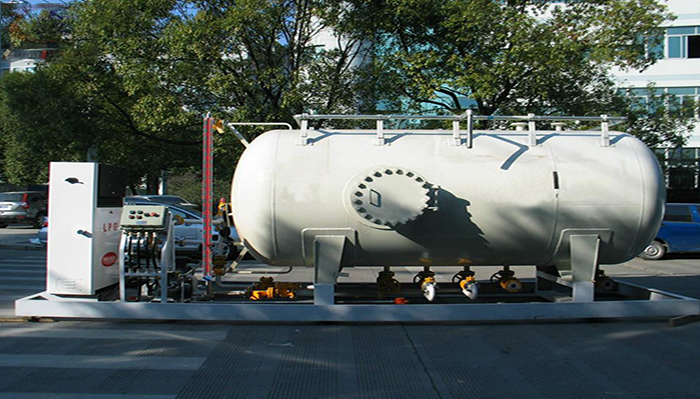Product Category
Overall inspection of skid filling station
Date: Nov 25, 2019

External inspection of LPG filling station
Also known as in-service inspection, the main contents of inspection include: whether there is any abnormal phenomenon such as crack, deformation, leakage, local overheating on the external surface of the pressure vessel; whether the safety accessories are complete, sensitive and reliable; whether the fastening bolts are in good condition and tightened completely; whether the foundation sinks, inclines and whether the anti-corrosion coating is damaged.
External inspection is not only the work of inspectors, but also the routine patrol inspection items of operators. In case of safety hazards (such as cracks, deformation and serious leakage of pressure components), it shall be shut down and reported to relevant personnel in time.
Internal and external inspection of LPG skid station
The internal and external inspection of pressure vessel can only be carried out after the vehicle is stopped and the inside of the vessel is cleaned. The main contents of the inspection include all the contents of the external inspection, as well as the corrosion and wear phenomenon of the internal and external surfaces; check all the welds, the transition area of the head and other stress concentration parts for cracks with the naked eye and a magnifying glass, if necessary, check the internal quality of the welds with ultrasonic or radiographic flaw detection, and measure the wall thickness. If the measured wall thickness is less than the smaller wall thickness of the vessel, strength check shall be carried out again and measures for use or repair under pressure shall be put forward; for vessels that may cause changes in the metallographic structure of metal materials, metallographic inspection shall be carried out if necessary; main bolts of high-pressure and relatively high-pressure vessels shall be inspected by magnetic powder or coloring, and pressure vessels shall be inspected for cracks, etc.
If the measured wall thickness is less than the smaller wall thickness of the vessel, strength check shall be carried out again and measures for use or repair under pressure shall be put forward; for vessels that may cause changes in the metallographic structure of metal materials, metallographic inspection shall be carried out if necessary; main bolts of high-pressure and relatively high-pressure vessels shall be inspected by magnetic powder or coloring, and pressure vessels shall be inspected for cracks, etc.
Through the internal and external inspection, the causes of the inspected defects shall be analyzed and the handling suggestions shall be put forward. Re inspection shall be carried out after repair. The internal and external inspection cycle of pressure vessels is once every three years, but the inspection cycle of vessels with strong corrosive medium and highly toxic medium should be shortened. The inspection period should also be shortened for vessels with serious defects found in operation and vessels with poor welding quality and unknown material corrosion resistance to the medium.
In addition to the above inspection items, pressure test (generally hydrostatic test) shall be carried out for pressure vessel comprehensive inspection. The main welds shall be subject to NDT spot check or all welds inspection. However, for vessels with low pressure, non flammable or non-toxic, non corrosive medium, if no defect is found, after obtaining certain use experience, non-destructive testing may not be carried out. The comprehensive inspection cycle of containers is generally at least once every six years. The comprehensive inspection period can be appropriately extended for the qualified containers containing air and inert gas after obtaining the use experience and one or two internal and external inspections to confirm that there is no corrosion.
Also known as in-service inspection, the main contents of inspection include: whether there is any abnormal phenomenon such as crack, deformation, leakage, local overheating on the external surface of the pressure vessel; whether the safety accessories are complete, sensitive and reliable; whether the fastening bolts are in good condition and tightened completely; whether the foundation sinks, inclines and whether the anti-corrosion coating is damaged.
External inspection is not only the work of inspectors, but also the routine patrol inspection items of operators. In case of safety hazards (such as cracks, deformation and serious leakage of pressure components), it shall be shut down and reported to relevant personnel in time.
Internal and external inspection of LPG skid station
The internal and external inspection of pressure vessel can only be carried out after the vehicle is stopped and the inside of the vessel is cleaned. The main contents of the inspection include all the contents of the external inspection, as well as the corrosion and wear phenomenon of the internal and external surfaces; check all the welds, the transition area of the head and other stress concentration parts for cracks with the naked eye and a magnifying glass, if necessary, check the internal quality of the welds with ultrasonic or radiographic flaw detection, and measure the wall thickness.

Through the internal and external inspection, the causes of the inspected defects shall be analyzed and the handling suggestions shall be put forward. Re inspection shall be carried out after repair. The internal and external inspection cycle of pressure vessels is once every three years, but the inspection cycle of vessels with strong corrosive medium and highly toxic medium should be shortened. The inspection period should also be shortened for vessels with serious defects found in operation and vessels with poor welding quality and unknown material corrosion resistance to the medium.
In addition to the above inspection items, pressure test (generally hydrostatic test) shall be carried out for pressure vessel comprehensive inspection. The main welds shall be subject to NDT spot check or all welds inspection. However, for vessels with low pressure, non flammable or non-toxic, non corrosive medium, if no defect is found, after obtaining certain use experience, non-destructive testing may not be carried out. The comprehensive inspection cycle of containers is generally at least once every six years. The comprehensive inspection period can be appropriately extended for the qualified containers containing air and inert gas after obtaining the use experience and one or two internal and external inspections to confirm that there is no corrosion.
Last article:
Next article:
Send Your Inquiry
We not only provide a good product, but also provide high quality service. If you are interested in our products,
you can contact us in the following ways.
you can contact us in the following ways.







